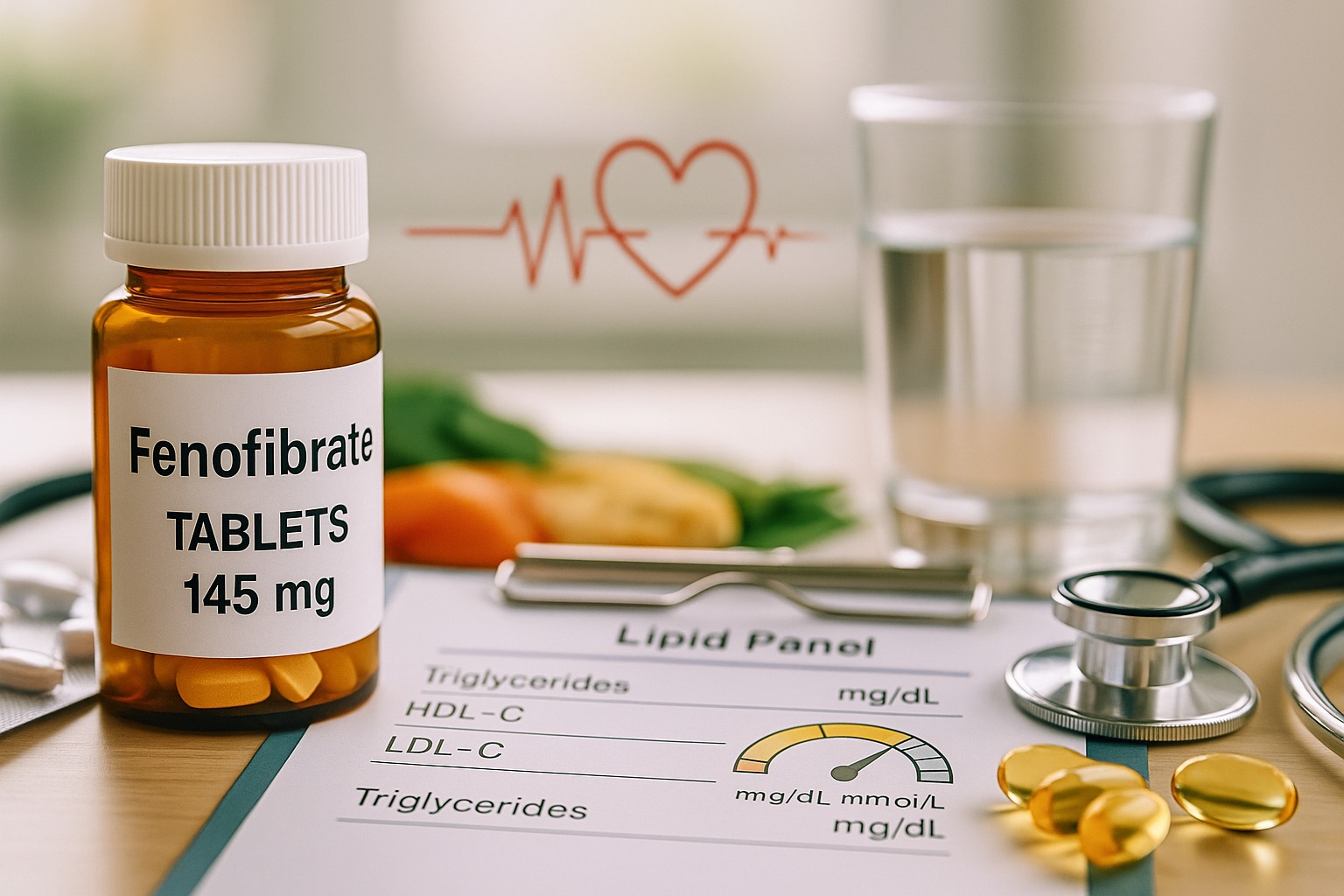Fenofibrate is a prescription lipid-lowering medicine used to treat high triglycerides and some types of mixed dyslipidaemia. When triglycerides are very high, lowering them helps reduce the risk of pancreatitis. In some people with atherogenic lipid patterns (high TG, low HDL-C), fenofibrate may be used alone or with a statin when a clinician believes the benefits outweigh the risks.
Education only—not medical advice. Dosing, indications, and monitoring can differ by country and product. Always follow your local prescriber and the exact package leaflet/Medication Guide.
What Is Fenofibrate?
- Class: Fibrate (PPAR-α agonist)
- What it does: Lowers triglycerides (TG) and VLDL, can raise HDL-C a little, and may modestly lower LDL-C (varies by baseline TG).
- Why it matters: Very high TG (about ≥500 mg/dL or ≥5.6 mmol/L) increases pancreatitis risk. Lowering TG is the priority in this range.
How Fenofibrate Works (in plain language)
Fenofibrate switches on liver and muscle pathways (via PPAR-α) that burn fatty acids and clear triglyceride-rich particles from the blood. Over weeks, this reduces TG and non-HDL cholesterol and may shrink small, dense LDL particles.
Who Might Be Offered Fenofibrate?
Your clinician may consider fenofibrate if you have one or more of the following:
- Very high triglycerides (often ≥500 mg/dL | 5.6 mmol/L) to reduce pancreatitis risk
- Persistent TG elevation (e.g., 150–499 mg/dL | 1.7–5.6 mmol/L) with low HDL-C despite lifestyle and statin therapy
- Mixed dyslipidaemia when non-HDL-C remains above goal despite first-line therapy
- Statin intolerance where a fibrate is judged appropriate
Not for everyone. People with active liver disease, severe kidney disease, or gallbladder disease usually should not use fenofibrate. It is not recommended in pregnancy or while breastfeeding.
Dosage & How to Take It
Products and strengths vary by country (e.g., 48/54/67/120/134/145/160 mg). Formulations are not automatically interchangeable. Follow the exact brand instructions.
- Typical adult dosing: once daily (most tablets/capsules). Many modern formulations can be taken with or without food; some older forms require food for absorption—check your leaflet.
- Kidney function: dose reduction is often required when eGFR is reduced; avoid in severe renal impairment (follow local label).
- Bile acid sequestrants (cholestyramine/colesevelam): take fenofibrate 1 hour before or 4–6 hours after to avoid binding.
- Missed dose: take the same day when remembered; skip if close to the next dose—don’t double.
Monitoring plan (common in many regions)
- Lipid panel: 4–8 weeks after starting or changing dose
- Liver enzymes & kidney function: baseline and periodically
- CK (creatine kinase): if you develop muscle pain/weakness
Side Effects
Common (often mild):
- Stomach upset, nausea, diarrhoea
- Headache
- Elevation in liver enzymes (usually temporary)
Important—contact your clinician promptly if you notice:
- Muscle pain, tenderness, or weakness (especially with a statin) → risk of myopathy/rhabdomyolysis is lower vs gemfibrozil but still possible
- Signs of liver problems: dark urine, yellowing skin/eyes, severe fatigue
- Gallbladder symptoms: right-upper abdominal pain, nausea, vomiting
- Reduced kidney function: notable change in urination or swelling
Interesting note: fenofibrate can lower uric acid, which may benefit some people with gout.
Interactions to Know
- Statins: may be combined cautiously in selected patients; report muscle symptoms immediately.
- Warfarin and other vitamin K antagonists: fenofibrate can increase INR—extra monitoring and dose adjustments may be required.
- Bile acid sequestrants: separate doses as above.
- Cyclosporine: increased risk of kidney problems—specialist oversight needed.
- Always share a complete list of prescriptions, OTC medicines, and supplements with your pharmacist/clinician.
Fenofibrate vs. Statins (and Where Each Fits)
- Statins are first-line to lower LDL-C and reduce heart-attack/stroke risk.
- Fenofibrate mainly targets triglycerides and non-HDL-C.
- In people with TG 200–499 mg/dL (2.3–5.6 mmol/L) and low HDL-C despite a statin, a clinician may consider adding fenofibrate if the expected benefits outweigh risks.
- For TG ≥500 mg/dL (≥5.6 mmol/L), reducing TG (fenofibrate, omega-3s, alcohol/sugar reduction) is prioritized to help prevent pancreatitis.
(Exact thresholds and recommendations can differ by country; your clinician follows local guidelines.)
Lifestyle Still Matters (wherever you live)
- Cut back on alcohol and sugary drinks—they drive triglycerides up
- Choose unsaturated fats, increase fibre, and limit refined carbs
- Weight management and regular activity improve TG and HDL-C
- Manage diabetes/insulin resistance, thyroid disease, and review medicines that raise TG (e.g., some steroids, oestrogens, retinoids)
FAQs (Quick Answers)
- How long until it works?
Triglycerides usually start falling within 2–4 weeks; check a lipid panel after dose changes. - Can I take it with a statin?
Sometimes—your clinician will decide. Report muscle symptoms right away. - Do I need to take it with food?
Depends on the brand/formulation in your country. Check your leaflet or ask your pharmacist. - Is it safe with warfarin?
It can raise INR. If you take warfarin, you’ll need closer monitoring when fenofibrate is started or stopped. - Will it help my LDL cholesterol?
It mainly lowers TG and non-HDL-C; LDL-C effects vary. Many people still need a statin for LDL goals. - What if my kidneys aren’t perfect?
Dose reductions may be needed; in severe impairment it’s usually avoided. Kidney tests are checked regularly. - Pregnancy or breastfeeding?
Generally not recommended—discuss alternatives with your clinician. - Can fenofibrate cause gallstones?
It can increase gallstone risk in susceptible people; report biliary-type pain. - Any benefit for gout?
Fenofibrate can lower uric acid, which may help some with gout (not a substitute for gout therapy). - What else lowers triglycerides?
Alcohol reduction, weight loss, lower-sugar diet, omega-3 fatty acids, and good diabetes control.
Bottom Line
Fenofibrate is a targeted tool for high triglycerides and select mixed lipid disorders. Used correctly—with the right formulation, monitoring, and lifestyle changes—it can meaningfully improve your lipid profile and help protect against pancreatitis. For long-term cardiovascular protection, many people still need a statin plus healthy daily habits.


Leave a Comment